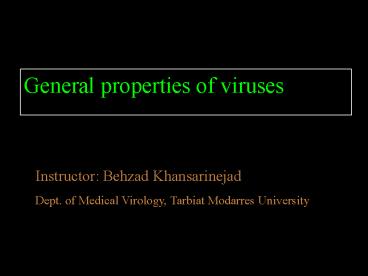Replication of Viruses: An Overview - PowerPoint PPT Presentation
1 / 28
Title:
Replication of Viruses: An Overview
Description:
Classification of Viruses Virus family names have the suffix -viridae ... pH Radiation Photodynamic Inactivation Ether Susceptibility Detergents ... – PowerPoint PPT presentation
Number of Views:105
Avg rating:3.0/5.0
Title: Replication of Viruses: An Overview
1
General properties of viruses
Instructor Behzad Khansarinejad Dept. of Medical
Virology, Tarbiat Modarres University
2
(No Transcript)
3
Evolutionary Origin of Viruses
- Viruses may be derived from DNA or RNA nucleic
acid components of host cells that became able to
replicate autonomously and evolve independently. - Viruses may be degenerate forms of intracellular
parasites - Viruses may be the first form of the living
material - May be they come from another planet !?
4
Classification of Viruses
- Virus family names have the suffix -viridae
- Genus names carry the suffix virus
- In four families (Poxviridae, Herpesviridae,
Parvoviridae, Paramyxoviridae), a larger grouping
called subfamilies has been defined( - Virinae) - Virus orders may be used to group virus families
that share common characteristics(
mononegavirales, Nidovirales)
5
Cubic symmetry (Icosahedral )
6
Helical Symmetry
7
Measuring the Sizes of Viruses
- Direct Observation in the Electron Microscope
- Sedimentation in the Ultracentrifuge
- Comparative Measurements
8
Virus Genomes
Single Stranded
DNA
Double Stranded
Nucleic Acid
Double Stranded
Positive
RNA
Single Stranded
Negative
RNA
DNA
9
(No Transcript)
10
Reaction to Physical Chemical Agents
- Heat Cold
- Stabilization of Viruses by Salts
- pH
- Radiation
- Photodynamic Inactivation
- Ether Susceptibility
- Detergents
- Formaldehyde
- Antibiotics Other Antibacterial Agents
11
Replication of Viruses An Overview
- Attachment
12
(No Transcript)
13
- Penetration or Engulfment
- Receptor-mediated endocytosis ( Viropexis)
- Fusion
- Direct penetration of virus particles across the
plasma membrane - (Translocation)
14
endocytosis ( Viropexis)
15
Fusion
16
Direct penetration
17
- Uncoating
- Eclipse period
- Expression of Viral Genomes and Synthesis of
Viral Components - Assembly
- Release
18
(No Transcript)
19
Techniques used for Detection of Viruses
- Electron microscopy
- 2. Serological assays ( ELISA, IF, CF, NT, RIA)
- molecular assays ( PCR, RT-PCR, NASBA, Real
Time-PCR) - Viral cultivation
20
PCR Principles
21
Hosts for Virus Cultivation
Laboratory Animals Embryonated Chicken
Eggs Cell Culture
22
Laboratory Animals
23
Embryonated Chicken Eggs
24
Cell culture
Primary Cell Culture Cell Strains Cell Lines
25
Primary Cell Culture
26
Subculture
27
Detection of Virus-Infected Cells
28
Inclusion bodies
Negri bodies in a rabies infected cell































